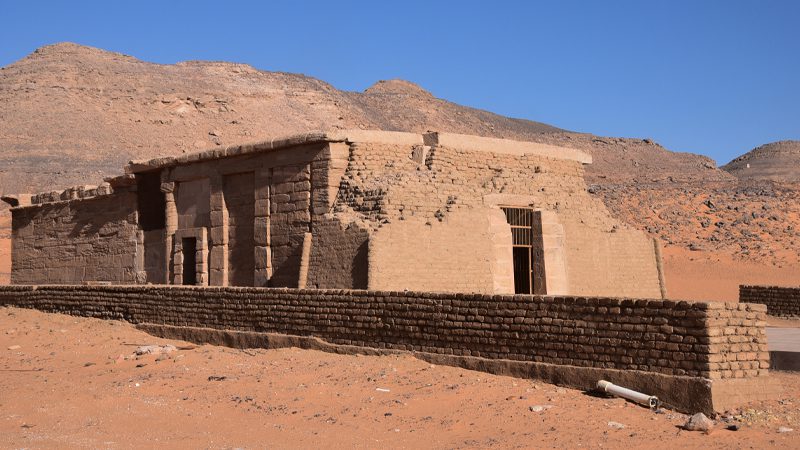On the tranquil banks of the majestic Nile River lies the Temple of Amada, an ancient sanctuary that beckons travelers with its awe-inspiring grandeur and historical significance. Steeped in the rich tapestry of Egyptian mythology and culture, this remarkable temple is a testament to ancient civilizations’ architectural prowess and religious devotion. In this article, we will embark on a journey to unravel the mysteries of the Temple of Amada, exploring its captivating history, architectural splendor, and cultural treasures.


The History of the Temple of Amada:
The Temple of Amada holds a storied past that dates back over 3,000 years. Built during the reign of Pharaoh Thutmose III of the New Kingdom, the temple served as a tribute to the god Amun-Ra and was later expanded and modified by subsequent pharaohs. It is one of the oldest surviving structures in Egypt, offering a glimpse into the time’s religious practices and cultural beliefs.
Architectural Marvels:
The Temple of Amada showcases a harmonious blend of architectural styles, reflecting the influence of different periods. Its grand entrance is adorned with intricate carvings and colossal statues, inviting visitors into a world of ancient grandeur. Inside, magnificent columns, detailed reliefs, and vibrant wall paintings captivate the eye, revealing tales of gods, pharaohs, and sacred rituals.
Cultural Treasures:
Within the temple’s hallowed halls lie cultural treasures that bring Egypt’s past to life. The walls are adorned with vibrant hieroglyphic inscriptions and intricate reliefs depicting mythical stories, historical events, and religious ceremonies. These ancient artworks provide invaluable insights into the lives, beliefs, and customs of the people who once worshiped within these sacred walls.
Preservation Efforts:
Preserving the legacy of the Temple of Amada is a paramount undertaking. Recognizing its historical significance, the Egyptian government and various organizations have dedicated efforts to protect and conserve the temple. Restoration projects aim to safeguard architectural integrity, preserve delicate wall paintings, and ensure that future generations can continue appreciating the temple’s splendor.
Visiting the Temple of Amada:
Careful planning and preparation are crucial to immerse yourself in the Temple of Amada’s wonders fully. The temple is located in the Aswan region of Egypt, and it is advisable to arrange transportation and guides in advance. As with any historical site, respecting the temple’s sanctity by adhering to visitor guidelines and regulations is essential.
The Future of the Temple of Amada:
As the world embraces cultural tourism and an increasing interest in ancient history, the Temple of Amada has the potential to become a more prominent destination for travelers seeking immersive experiences. Continued preservation efforts, sustainable tourism practices, and enhanced accessibility can help showcase the temple’s magnificence while protecting its authenticity for future generations.
What is the Temple of Amada?
The Temple of Amada is an ancient sanctuary in Egypt near the banks of the Nile River. It is a historic temple that dates back over 3,000 years and is dedicated to worshiping Amun-Ra.
How can I reach the Temple of Amada?
The Temple of Amada is situated in the Aswan region of Egypt. To reach the temple, you can arrange transportation from Aswan by boat or by joining organized tours. It is advisable to plan your visit and seek the assistance of local guides.
What can I expect to see at the Temple of Amada?
You can expect magnificent architectural features at the Temple of Amada, including intricate carvings, colossal statues, and vibrant wall paintings. The temple is adorned with hieroglyphic inscriptions and reliefs that depict ancient Egyptian mythology, historical events, and religious rituals.
Is the Temple of Amada well-preserved?
The Temple of Amada has undergone preservation efforts to protect its historical and cultural significance. The Egyptian government and various organizations have conducted restoration projects to safeguard the temple’s architectural integrity and preserve its delicate artworks.
Can I take photographs inside the Temple of Amada?
Photography is generally allowed inside the Temple of Amada; however, specific guidelines may apply. It is essential to respect the temple’s rules and regulations regarding photography, including restrictions on flash photography or tripods.
Are there other attractions near the Temple of Amada?
Yes, there are other notable attractions near the Temple of Amada that you can explore. These include the Philae Temple, the Aswan High Dam, and the Nubian Museum. These sites offer further insights into Egypt’s ancient history and cultural heritage.
Conclusion:
The Temple of Amada is a testament to Egypt’s rich cultural heritage, offering a captivating glimpse into ancient civilizations’ religious and architectural achievements. Its grandeur, intricate artwork, and cultural significance make it a must-visit destination for history enthusiasts and curious travelers. Embark on a journey to the Temple of Amada, and you will be transported back in time, connecting with the spiritual essence and timeless beauty that define this remarkable sanctuary along the banks of the Nile.
